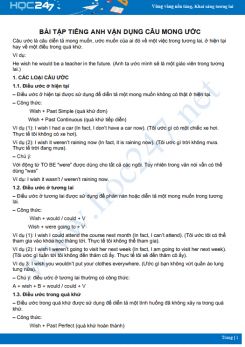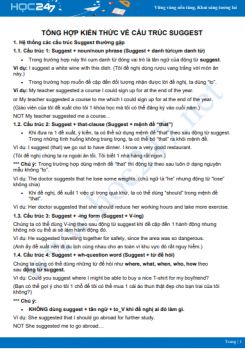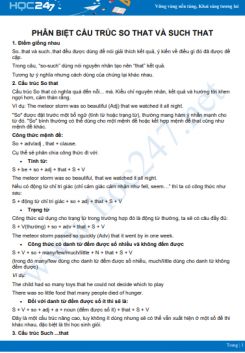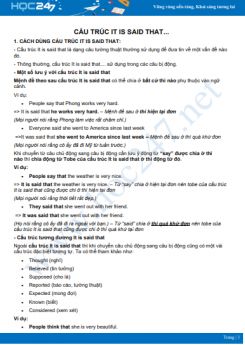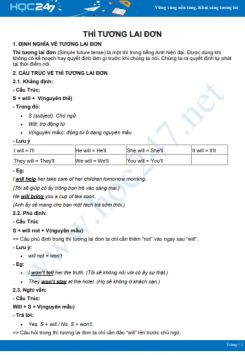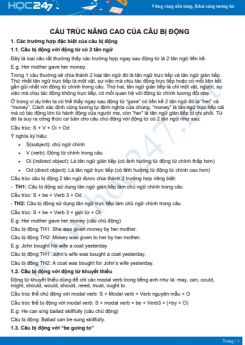Nhằm mục đích có thêm tài liệu cung cấp giúp các em học sinh lớp 11 có tài liệu ôn tập rèn luyện về nội dung kiến thức từng trường hợp sửu dụng cụ thể Câu gián tiếp. HOC247 giới thiệu đến các em tài liệu Cách dùng câu gián tiếp trong Tiếng Anh với phần lý thuyết và bài tập kèm đáp án, lời giải chi tiết. Hi vọng tài liệu sẽ giúp ích cho các em.
Chúc các em có kết quả học tập tốt!
CÁCH DÙNG CÂU GIÁN TIẾP TRONG TIẾNG ANH
1. Định nghĩa
Câu tường thuật (hay còn gọi là câu nói gián tiếp) là cách nói mà ta dùng để tường thuật hay kể lại cho ai đó nghe những gì người khác nói hoặc đang nói.
Ví dụ:
He said “I bought a new motorbike for myself yesterday”.
=> He said he had bought a new motorbike for himself the day before.
2. Các yếu tố biến đổi trong lời nói gián tiếp
1. Thời của động từ
2. Đại từ nhân xưng
3. Đại từ sở hữu
4. Đại từ chỉ định
5. Trạng từ không gian
6. Trạng từ thời gian
2.1. Thì của động từ
1. Hiện tại đơn -> Quá khứ đơn
2. Hiên tại tiếp diễn -> Quá khứtiếp diễn
3. Hiện tại hoàn thành -> Quá khứ hoàn thànli
4. Quá khứ đơn -> Quá khứ hoàn thành
5. Quá khứ tiếp diễn -> Quá khứ hoàn thành tiếp diễn
6. Tương lai đơn: will/ shall would/ should
7. Tương lai gần: be going to -> was/were going to
2.2. Động từ khuyết thiếu cũng lùi về 1 thời so với câu trực tiếp:
1. can => could
2. will=> would
3. shall => should
4. must => had to
5. may => might
2.3. Đại từ nhân xưng trong câu gián tiếp thay đổi phù hợp với vai trò người trần thuât
1. I -> he/she
2. we->they
3. you -> they/l/he/her
4. me -> him/her
5. us -> them
6. you -> them/me/him/her
2.4. Đại từ sở hữu trong câu gián tiếp thay đổi phù hợp với vai trò người trần thuật
1. my -> her/his
2. our > their
3. your -> them/my/his/her
4. mine > his/hers
5. ours -> theirs
6. yours -> theirs/mine/his/hers
2.5. Đại từ chỉ trong câu gián tiếp sẽ thay đổi như sau
1. this -> that
2. these -> those
2.6. Trạng từ chỉ thời gian thay đổi theo
1. Here-> There
2. Now-> Then
3. Today -> That day
4. Ago -> Before
5. Tomorrows The next day / the following day
6. The day after tomorrow -> In two day’s time / two days after
7. Yesterday ->The day before / the previous day
8. The day before yesterday -> Two day before
9. Next week -> The following week
10. Last week -> The previous week / the week before
11. Last year -> The previous year / the year before
3. Dạng câu gián tiếp đặc biệt
3.1. Câu hỏi dùng trợ động từ:
– Trong câu gián tiếp thêm “if” hoặc “whether” và mệnh đề theo sau biến đổi về dạng khẳng định.
– Công thức: S + asked + O + if / whether + S + V + O ….
– Động từ giới thiệu thường sử dụng: ask, wonder, want to know
– Ví dụ: She said “Do you want to go with me?” -> She asked if I wanted to with her.
3.2. Câu dùng từ để hỏi
– Trong câu gián tiếp phải biến đổi mệnh đề sau từ hỏi về dạng khẳng định.
– Công thức: S + asked + O + Wh- + S + V + O.
– Động từ giới thiệu thường sử dụng: ask, wonder, want to know
– Ví dụ: He asked “what time Witt you come?” -> He asked what time I woutd come.
3.3. Shall/ would dùng để diễn tả đề nghi, lời mời:
Ví dụ:
“Shall I bring you some tea?” he asked. -> He offered to bring me some tea
Tom asked: ’Shall we meet at the theatre?’ -> Tom suggested meeting at the theatre.
3.4. Will/would dùng để diễn tả sự yêu câu:
– Công thức: S + asked + (O) + to infinitive
Ví dụ:
“Will you help me, please?” -> He asked me to help him.
3.5. Câu mệnh lệnh và câu yêu c’âu trong lời nói gián tiếp.
– Công thức: S + told + (O) + (not) + to infinitive
Ví dụ:
” Go away!” -> He told me/The boys to go away.
3.6. Lời khuyên
– Công thức: Should/Had better / If I were you =>S + advised + (O) + (not) + to infinitive/ Hoặc: S + Say/tell (+ that) + chủ từ + should.
Ví dụ:
“You should turn off the lights, Mary” Jane said–> Jane advised Mary to turn off the lights
“If I were you, I would phone her,” he said. -> He advised me to phone her.
3.7. Câu cảm thán trong lời nói gián tiếp.
– Công thức: S + exclaimed + that + Clause
Ví dụ:
“What a lovely dress!” -> She exclaimed that the dress was lovely.
3.8. Câu gợi ý trong lời nói gián tiếp
– Công thức: Why don’t you / Why not / How about/ Let’s/ Shall we / It’s a good idea→ S+ suggested + (someone) + V-ing …
Ví dụ:
Why don’t you send her some flowers?” he said.→ He suggested me sending her some flowers.
“Let’s meet outside the cinema,” he said.→ He suggested meeting outside the cinema.
“It’s a good idea to go for a picnic this weekend,” she said→ She suggested going for a picnic that weekend.
3.9. Câu điều kiện
Nếu trong lời nói trực tiếp có câu điều kiện thì chỉ có câu điều kiện loại 1 là thay đổi về thì, câu điều kiện loại 2 và 3 vẫn giữ nguyên hình thức động từ của chúng.
Ví dụ:
“If I have time, I will visit her,” he said.→ He said that if he had time he would visit her.
She said: “If I had enough money, I would buy a car.”→ She said that if she had enough money she would buy a car.
3.10. Lời mời trong lời nói gián tiếp
– Công thức: Would you like / Will you → S + invited someone + to-inf
Ví dụ:
“Will you have lunch with me?” he said.→ He invited me to have lunch with him.
3.11. Các hình thức hỗn hợp trong lời nói gián tiếp.
Lời nói trực tiếp có thể bao gồm nhiều hình thức hỗn hợp: câu khẳng định, câu hỏi, câu mệnh lệnh, câu cảm thán:
Ví dụ: She said, “can you play the piano?” and I said “no” -> She asked me if could play the piano and I said that I could not.
4. Các động từ thường dùng
– tell/ told: Dùng ở trần thuật, kể lại
– ask/ wonder/ want to know: câu hỏi
– tell/ ask/ require/ request/ demand + sb + todost: Yêu cầu, đề nghị hay đòi hỏi ai làm gì.
– order sb to do st: ra lệnh cho ai làm gì.
– advise sb to do st: khuyên ai đó nên làm gì.
– invite sb to dost: mời ai đó
– exclaim :dùng cho câu cảm thán
– apologize (to sb) for st/ fordoing st: xin lỗi(ai) về điều gì/ vì đã làm gì
– remind sb to dost: Nhắc nhở ai làm gì
– accuse sb of St/ doing St: Buộc tội ai điều gì/ vì đã tàm gì
– s + promised + (not) to V: dùng dể hứa
– Congratulated on: chúc mừng
– Dreamed of: mơ ước
-Thanked…..for: cảm ơn
– Insisted on: năn nỉ
– Looked forward to: mong đợi
-Admitted: thừa nhận
-Suggested: gợi ý
-Think of: nhớ về
– Denied: từ chối
– Prevented……..from: ngăn cản
– Stop………..from: dừng lại
– Warn …….against: cảnh báo
5. Bài tập
5.1. Bài 1: Hoàn thành các câu sau
1. “Where is my umbrella?” she asked.
She asked……………………………………… ………………….
2. “How are you?” Martin asked us.
Martin asked us………………………………………… ……………….
3. He asked, “Do I have to do it?”
He asked……………………………………… ………………….
4. “Where have you been?” the mother asked her daughter.
The mother asked her daughter…………………………………… …………………….
5. “Which dress do you like best?” she asked her boyfriend.
She asked her boyfriend………………………………….. ……………………..
6. “What are they doing?” she asked.
She wanted to know………………………………………. …………………
7. “Are you going to the cinema?” he asked me.
He wanted to know………………………………………. …………………
8. The teacher asked, “Who speaks English?”
The teacher wanted to know………………………………………. …………………
9. “How do you know that?” she asked me.
She asked me………………………………………… ……………….
10. “Has Caron talked to Kevin?” my friend asked me.
My friend asked me………………………………………… ……………….
11. “What’s the time?” he asked.
→ He wanted to know ……………………………………………
12. “When will we meet again?” she asked me.
→ She asked me ……………………………………………
13. “Are you crazy?” she asked him.
→ She asked him ……………………………………………
14. “Where did they live?” he asked.
→ He wanted to know ……………………………………………
15. “Will you be at the party?” he asked her.
→ He asked her ……………………………………………
16. “Can you meet me at the station?” she asked me.
→ She asked me ……………………………………………
17. “Who knows the answer?” the teacher asked.
→ The teacher wanted to know ……………………………………………
18. “Why don’t you help me?” she asked him.
→ She wanted to know ……………………………………………
19. “Did you see that car?” he asked me.
→ He asked me ……………………………………………
20. “Have you tidied up your room?” the mother asked the twins.
→ The mother asked the twins …………………………………………..
5.2. Bài 2: Bài tập câu tường thuật pha trộn negative và positive
1. She said, “Go upstairs.”
→ She told me ……………………………………………
2. “Close the door behind you,” he told me.
→ He told me ……………………………………………
3. “Don’t be late,” he advised us.
→ He advised us ……………………………………………
4. “Stop staring at me,” she said.
→ She told him ……………………………………………
5. “Don’t be angry with me,” he said.
→ He asked her ……………………………………………
6. “Leave me alone,” she said.
→ She told me ……………………………………………
7. “Don’t drink and drive,” she warned us.
→ She warned us ……………………………………………
8. “John, stop smoking,” she said.
→ She told John ……………………………………………
9. “Don’t worry about us,” they said.
→ They told her ……………………………………………
10. “Meet me at the cinema.” he said.
→ He asked me ……………………………………………
11. He said, “I like this song.”
→ He said ……………………………………………
12. “Where is your sister?” she asked me.
→ She asked me ……………………………………………
13. “I don’t speak Italian,” she said.
→ She said ……………………………………………
14. “Say hello to Jim,” they said.
→ They asked me ……………………………………………
15. “The film began at seven o’clock,” he said.
→ He said that ……………………………………………
16. “Don’t play on the grass, boys,” she said.
→ She told ……………………………………………
17. “Where have you spent your money?” she asked him.
→ She asked him ……………………………………………
18. “I never make mistakes,” he said.
→ He said ……………………………………………
19. “Does she know Robert?” he wanted to know.
→ He wanted ……………………………………………
20. “Don’t try this at home,” the stuntman told the audience.
→ The stuntman advised ……………………………………………
6. Đáp án
6.1. Bài 1: Hoàn thành các câu
1. She asked me where her umbrella was.
2. Martin asked us how we were.
3. He asked if he had to do it.
4. The mother asked her daughter where she had been.
5. She asked her boyfriend which dress he liked best.
6. She wanted to know what they were doing.
7. He wanted to know if I was going to the cinema.
8. The teacher wanted to know who spoke English.
9. She asked me how I knew that.
10. My friend asked me if Caron had talked to Kevin.
11. He wanted to know what time it was.
12. She asked me when we would meet again.
13. She asked him if he was crazy.
14. He wanted to know where they had lived.
15. He asked her if she would be at the party.
16. She asked me if I could meet her at the station.
17. The teacher wanted to know who knew the answer.
18. She wanted to know why he didn’t help her.
19. He asked me if I had seen that car.
20. The mother asked the twins if they had tidied up their room.
6.2. Bài 2: Câu tường thuật pha trộn negative và positive
1. She told me to go upstairs.
2. He told me to close the door behind me.
3. He advised us not to be late.
4. She told him to stop staring at her.
5. He asked her not to be angry with him.
6. She told me to leave her alone.
7. She warned us not to drink and drive.
8. She told John to stop smoking.
9. They told her not to worry about them.
10. He asked me to meet him at the cinema.
11. He said that he liked that song.
12. She asked me where my sister was.
13. She said that she didn’t speak Italian.
14. They asked me to say hello to Jim.
15. He said that the film began at seven o’clock.
16. She told the boys not to play on the grass.
17. She asked him where he had spent his money.
18. He said that he never made mistakes.
19. He wanted to know if she knew Robert.
20. The stuntman advised the audience not to try that at home.
Trên đây là một phần trích đoạn nội dung Cách dùng câu gián tiếp trong Tiếng Anh. Để xem thêm nhiều tài liệu tham khảo hữu ích khác các em chọn chức năng xem online hoặc đăng nhập vào trang hoc247.net để tải tài liệu về máy tính.
Hy vọng tài liệu này sẽ giúp các em học sinh ôn tập tốt và đạt thành tích cao trong học tập.
Mời các em tham khảo các tài liệu có liên quan:
- Bài tập Tiếng Anh vận dụng câu mong ước
- Tổng hợp kiến thức về Cấu trúc Suggest
- Phân biệt cấu trúc So that và Such that
Chúc các em học tập tốt!






